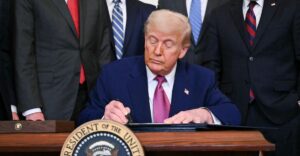
FRANKFURT, Germany — The European Union, America’s largest trading partner, is on edge as it awaits a crucial decision from U.S. President Donald Trump. On Monday, the administration is expected to announce whether it will impose substantial tariffs on European goods, a move that economists warn could have significant repercussions for businesses and consumers on both sides of the Atlantic.
In early April, President Trump initiated a 20% import tax on all EU-made products, part of a broader strategy targeting countries with which the U.S. has a trade imbalance. However, these tariffs were temporarily reduced to a standard rate of 10% until July 9, allowing time for negotiations and calming financial markets. Despite this, Trump has expressed dissatisfaction with the EU’s stance in trade talks, threatening to increase tariffs on European exports to a staggering 50%.
The Stakes of US-EU Trade
The economic implications of these tariffs are profound. The trade relationship between the U.S. and the EU is described by the EU’s executive commission as “the most important commercial relationship in the world.” In 2024, the value of trade in goods and services between these two economic giants amounted to 1.7 trillion euros ($2 trillion), averaging 4.6 billion euros daily, according to Eurostat.
The U.S. primarily exports crude oil, pharmaceuticals, aircraft, automobiles, and medical equipment to Europe. Conversely, Europe’s significant exports to the U.S. include pharmaceuticals, cars, aircraft, chemicals, medical instruments, and wine and spirits. However, the EU maintains a trade surplus, with Americans purchasing more European goods than vice versa.
Underlying Issues in Trade Negotiations
Historically, the U.S. and the EU have maintained a cooperative trade relationship with low tariff levels. Before Trump’s recent policies, the average U.S. tariff on European goods was 1.47%, while the EU’s was 1.35% on American products. However, the current administration has adopted a more confrontational approach, imposing a 50% tariff on steel and aluminum and a 25% tax on imported automobiles and parts.
Several contentious issues remain unresolved. The Trump administration has raised concerns about EU agricultural barriers, such as bans on chlorine-washed chicken and hormone-treated beef. Additionally, President Trump has criticized Europe’s value-added taxes (VAT), which range from 17% to 27% and apply to both domestic and imported goods. Despite these criticisms, many economists argue that VAT is trade-neutral.
“On the thorny issues of regulations, consumer standards and taxes, the EU and its member states cannot give much ground,” said Holger Schmieding, chief economist at Germany’s Berenberg bank. “They cannot change the way they run the EU’s vast internal market according to U.S. demands, which are often rooted in a faulty understanding of how the EU works.”
Potential Impacts of Increased Tariffs
Economists and businesses warn that higher tariffs will likely lead to increased prices for U.S. consumers on imported goods. Importers will need to balance absorbing the additional costs against passing them onto customers. For instance, Mercedes-Benz dealers in the U.S. have stated they will maintain 2025 model year prices “until further notice,” despite potential significant price increases in the future.
Simon Hunt, CEO of Italian wine and spirits producer Campari Group, indicated that pricing strategies could vary depending on competitors’ actions. If rivals raise prices, Campari might hold prices steady to capture market share.
Trump argues that restricting foreign companies’ access to the U.S. market could stimulate American manufacturing. While some companies have dismissed this notion, others, like France-based luxury group LVMH, have considered shifting production to the U.S. to avoid tariffs.
“If we end up with high tariffs, … we will be forced to increase our U.S.-based production to avoid tariffs,” said LVMH CEO Bernard Arnault. “And if Europe fails to negotiate intelligently, that will be the consequence for many companies. … It will be the fault of Brussels, if it comes to that.”
Looking Ahead: Possible Outcomes
Many analysts expect President Trump to eventually retract his most severe tariff demands. A failure to reach an agreement could have significant economic consequences, with the EU potentially losing 0.3% of its GDP and the U.S. experiencing a 0.7% decline, according to a Bruegel think tank review.
Given the complexity of the issues, a framework deal might be established before the impending deadline, maintaining a 10% base tariff alongside existing tariffs on autos, steel, and aluminum until a formal agreement is reached.
“The most likely outcome of the trade talks is that the U.S. will agree to deals in which it takes back its worst threats of ‘retaliatory’ tariffs well beyond 10%,” Schmieding noted. “However, the road to get there could be rocky.”
Offering exemptions for certain goods might facilitate a deal, with the EU potentially easing some regulations viewed as trade barriers by the U.S. While President Trump might present such an outcome as a victory, the real impact of protectionism would largely affect U.S. consumers.







